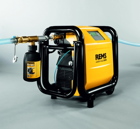Commissioning potable-water installations

Steven Mesher of REMS (UK) looks at the requirement for the avoidance/ removal of bacterial contamination during the commissioning of potable-water installations and how it impacts on the installer.
European Standard EN 806-4 – came into force throughout Europe in 2010. This standard defines Europe-wide regulations for the commissioning of potable-water installations — for example for filling, pressure testing, flushing and disinfection.
But, does the installer have to observe/fulfil the standard?
The installer must ensure a hygienically perfect installation. If not, the builder could be entitled to claim that the installer which carried out the work should repair any damages caused by bacterial contamination.
Here, the installer must prove, in the case of damage, if necessary by an independent expert, that the work carried out is in accordance with the standard. If this is not the case, then the installer is liable for the damage. Therefore it is urgently recommended to satisfy the requirements of the standard to reduce the liability risk by carrying out the procedures discussed below.
Pressure testing and flushing
The first procedure is to pressure test and flush with water and/ or air.
EN 806-4, Section 6 ‘Commissioning’ deals in 6.1 with the filling and pressure testing of installations inside buildings for water for human consumption. This can be done either with water or clean air with low pressure or inert gases. The possible risk from high gas or air pressure in the system must be considered. Apart from this note, the EN 806-4 contains no test criteria whatsoever for testing with air.
Water pressure testing, on the other hand, has three test methods, depending on the material and size of the installed pipes. The test methods vary in different test sequences, pressures and times. The leak test with water usually performed in the past was performed before covering the water pipes. If the installation is then not put into operation immediately afterwards, there is a risk of bacterial contamination both in filled, partially filled and emptied pipes.
EN 806-4 therefore prescribes that a potable-water installation must be flushed and pressure tested as soon as possible after installation and immediately before putting into operation with potable water. If a system is not put into operation immediately after commissioning, it must be flushed at regular intervals (up to seven days). The leak test with compressed air avoids the potable-water installation having to be flushed every seven days. Water or a water/air mixture can be used for flushing.
According to EN 806-4, the water used for flushing must be filtered to retain particles ≥150 μm and the water must be of perfect drinking quality. The system must be flushed section by section, depending on the size of the installation, the arrangement and layout of the pipes. Flushing must start on the lowest floor of the building and continue upwards line by line.
The minimum flow velocity when flushing the installation must be 2 m/s, and the water in the system must be replaced at least 20 times during flushing. No flushed section may exceed a pipe section length of 100 m. Furthermore, bacterial contamination and incrustations are often only removed in part by flushing with water alone, so it is recommended to reinforce the cleaning effect by adding compressed-air surges to the water.
Disinfection
The second procedure is disinfection.
EN 806-4 prescribes that potable-water installations may be disinfected after flushing, where there is a need to do so. All chemicals are used for disinfecting potable-water installations must meet the requirements for chemicals for water treatment which are defined in European standards. Transport, storage, handling and application of all these disinfectants can be dangerous, so health-and-safety regulations must be strictly observed.
Hydrogen peroxide is often recommended to disinfect potable-water installations. Because of its rapid decomposition, weak disinfection solutions of hydrogen peroxide can be drained into sewers without problems. In addition, concentrations of hydrogen peroxide <5% are not classified as dangerous and are therefore not hazardous.
The recommended use of dosing solutions is a concentration of 1.5% hydrogen peroxide per 100 l of potable water, which gives a disinfection solution of 150 mg/l of hydrogen peroxide.
In accordance with EN 806-4 , records of the testing, flushing and disinfection process, as well as inspection results, must be submitted to the owner of the building for the documentation process.
Steven Mesher, Managing Director of REMS (UK).







